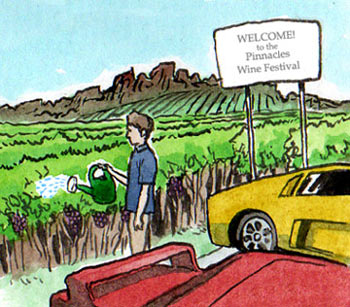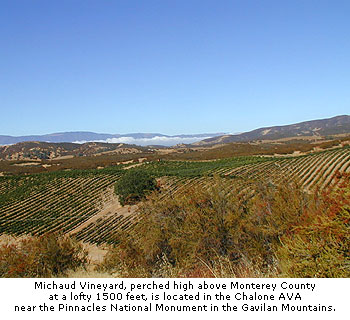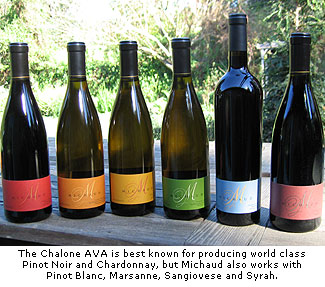

The Pinnacles Wines Festival is a showcase for wines
made in the Chalone AVA, many of which are produced
by some of California's most prolific wineries.
Investigating the Terroir of the Chalone AVA: An interview with Michael Michaud
"These are very distinctive wines with much in common with the wines produced in Burgundy. This is likely due to the vivid minerality captured in the wines made in the Chalone AVA."
by
Laurie Daniel
November 13, 2006
Laurie Daniel (LD): How is the Chalone AVA distinct from the broader Monterey AVA? Does the Chalone AVA have a defining characteristic such as climate, soil or something else?
 Michael Michaud (MM): The Chalone AVA has elevations ranging from 1,500 to 1,800 feet, and it has an unusual soil composition (decomposed granite and limestone and assorted types of volcanic rocks, that drain very well). It also has a high desert ecology (low rainfall, low humidity, daily temperature swings of 40-60 degrees); and lots of sunlight (any fog usually recedes in the early morning, while much of the Salinas Valley may only receive a few hours of direct sunlight on foggy days). This intense sunlight creates vivid flavors in the grapes as well as ample tannins for good color and long aging.
Michael Michaud (MM): The Chalone AVA has elevations ranging from 1,500 to 1,800 feet, and it has an unusual soil composition (decomposed granite and limestone and assorted types of volcanic rocks, that drain very well). It also has a high desert ecology (low rainfall, low humidity, daily temperature swings of 40-60 degrees); and lots of sunlight (any fog usually recedes in the early morning, while much of the Salinas Valley may only receive a few hours of direct sunlight on foggy days). This intense sunlight creates vivid flavors in the grapes as well as ample tannins for good color and long aging.
All of the different exposures are available, as the appellation is essentially a rolling, hilly plateau on top of the Gavilan Mountain range. It is somewhat warmer at the southern end, because the air is dammed up by North Chalone Peak, which partially blocks the afternoon breeze. There are areas of geothermal heating as well, with below-ground temperatures of 73 degrees. This appellation produces wines that are very different than most of California’s other appellations. These are very distinctive wines with much in common with the wines produced in Burgundy. This is likely due to the vivid minerality captured in the wines made in the Chalone AVA.
LD: The AVA is best known for Chardonnay and Pinot Noir. Why do those varieties do well there? Is one better suited to the Chalone AVA than the other?
MM: They both do a lot better now since they receive adequate irrigation as compared with the dry years preceding Chalone Vineyard’s pipeline system (built in 1986 to carry water from the Salinas Valley). Both varieties ripen easily given the sunlight and warmth. They ripen essentially at the same time, although some years one will ripen several days to a week before the other. The acidity is preserved by the cool/cold nights but is also somewhat reduced by the soil’s alkalinity. The vines take up a lot of the minerals, and that minerality is a strong component of the local terroir expressed in the wine.
The only real difference is that Chardonnay is susceptible to powdery mildew, which is found throughout the appellation, while Pinot Noir is not as affected by this problem.
LD: You talked about the big temperature swings. Highs during the summer can be quite hot. Sometimes it would seem too hot for Chardonnay and Pinot Noir. Do you take any special measures in the vineyard to mitigate the effects of high temperatures?
 MM: About the only thing we can do is to make sure that we’re irrigating. We irrigate twice a week.
MM: About the only thing we can do is to make sure that we’re irrigating. We irrigate twice a week.
LD: What other grape varieties show promise in the AVA?
MM: Syrah, Sangiovese, Muscat, Pinot Blanc (Melon de Bourgogne), Marsanne, Chenin Blanc and Cabernet Sauvignon have all been grown here, with outstanding wines produced. Zinfandel, Grenache and other Rhone varieties such as Tempranillo, Mourvedre and Albarino would probably all do well here, although Mourvedre ripens very late in this region.
LD: Which of these are you growing?
MM: Sangiovese, Syrah, Pinot Blanc -- which, as you know, is Melon -- Chardonnay, Pinot Noir and Marsanne.
LD: Is there a regional style for Chalone Pinot Noir? What about Chardonnay?
MM: At the moment, I am not sure that there is a definable regional style. At this time, there is a range of styles, from late picked to ripe fruit at 23 degrees Brix, with a range of acidity from soft to fresh, and no oak to all new oak. One characteristic of the appellation is that it produces wines that tend to be closed and tight in their youth and are able to age for a long time. I once had a 1969 Chalone Chardonnay that was 20 years old and tasted like it was 3 to 5 years old.
The old Chalone Pinot Noirs were great after 20 years as well, but required 3 to 5 years of bottle age to loosen up. Newer clonal selections, adequate irrigation and different winemaking techniques like whole cluster pressing, exclusion of stems for reds and use of native yeast have softened the tannins and improved the wines’ accessibility without compromising their ability to age. The regional style for both Chardonnay and Pinot Noir made in the AVA shows minerality and vivid fruit characters with good acidity.
LD: Are there particular clones of Chardonnay that do better in your AVA? What about Pinot Noir?
MM: The old Wente field selection of Chardonnay planted in 1946 by William Silvear thrives here and produces wines with flavors reminiscent of apricots, nectarines and peaches. The wines have a smooth texture and satisfying viscosity that you don’t often find. Mount Eden and Stony Hill clones of Chardonnay produce wines similar to the Wente and probably were taken from the same initial source.
Silvear also planted a small cluster, small berry Pinot Noir clone that has lovely aromas and flavors but is light in color when grown on the high limestone content of that vineyard and is rather tannic. Dick Graff had selected a few different Pinot clones in 1970 and 1973-4. One of those has a wonderful rose-like character and good color, soft texture and restrained tannins. The other Graff selection has ripe cherry, blackberry and spice characters, with good tannin balance and good color. The Dijon selections 113, 114, 115, 667 and 777 produce wines with great fruit aromas and favors as well as softer, supple tannins, which when blended with the older clones produce wines that are accessible sooner and more balanced and complete than the wines produced solely from the older clones.
LD: How has
 Michael Michaud (MM): The Chalone AVA has elevations ranging from 1,500 to 1,800 feet, and it has an unusual soil composition (decomposed granite and limestone and assorted types of volcanic rocks, that drain very well). It also has a high desert ecology (low rainfall, low humidity, daily temperature swings of 40-60 degrees); and lots of sunlight (any fog usually recedes in the early morning, while much of the Salinas Valley may only receive a few hours of direct sunlight on foggy days). This intense sunlight creates vivid flavors in the grapes as well as ample tannins for good color and long aging.
Michael Michaud (MM): The Chalone AVA has elevations ranging from 1,500 to 1,800 feet, and it has an unusual soil composition (decomposed granite and limestone and assorted types of volcanic rocks, that drain very well). It also has a high desert ecology (low rainfall, low humidity, daily temperature swings of 40-60 degrees); and lots of sunlight (any fog usually recedes in the early morning, while much of the Salinas Valley may only receive a few hours of direct sunlight on foggy days). This intense sunlight creates vivid flavors in the grapes as well as ample tannins for good color and long aging.All of the different exposures are available, as the appellation is essentially a rolling, hilly plateau on top of the Gavilan Mountain range. It is somewhat warmer at the southern end, because the air is dammed up by North Chalone Peak, which partially blocks the afternoon breeze. There are areas of geothermal heating as well, with below-ground temperatures of 73 degrees. This appellation produces wines that are very different than most of California’s other appellations. These are very distinctive wines with much in common with the wines produced in Burgundy. This is likely due to the vivid minerality captured in the wines made in the Chalone AVA.
LD: The AVA is best known for Chardonnay and Pinot Noir. Why do those varieties do well there? Is one better suited to the Chalone AVA than the other?
MM: They both do a lot better now since they receive adequate irrigation as compared with the dry years preceding Chalone Vineyard’s pipeline system (built in 1986 to carry water from the Salinas Valley). Both varieties ripen easily given the sunlight and warmth. They ripen essentially at the same time, although some years one will ripen several days to a week before the other. The acidity is preserved by the cool/cold nights but is also somewhat reduced by the soil’s alkalinity. The vines take up a lot of the minerals, and that minerality is a strong component of the local terroir expressed in the wine.
The only real difference is that Chardonnay is susceptible to powdery mildew, which is found throughout the appellation, while Pinot Noir is not as affected by this problem.
LD: You talked about the big temperature swings. Highs during the summer can be quite hot. Sometimes it would seem too hot for Chardonnay and Pinot Noir. Do you take any special measures in the vineyard to mitigate the effects of high temperatures?
 MM: About the only thing we can do is to make sure that we’re irrigating. We irrigate twice a week.
MM: About the only thing we can do is to make sure that we’re irrigating. We irrigate twice a week.LD: What other grape varieties show promise in the AVA?
MM: Syrah, Sangiovese, Muscat, Pinot Blanc (Melon de Bourgogne), Marsanne, Chenin Blanc and Cabernet Sauvignon have all been grown here, with outstanding wines produced. Zinfandel, Grenache and other Rhone varieties such as Tempranillo, Mourvedre and Albarino would probably all do well here, although Mourvedre ripens very late in this region.
LD: Which of these are you growing?
MM: Sangiovese, Syrah, Pinot Blanc -- which, as you know, is Melon -- Chardonnay, Pinot Noir and Marsanne.
LD: Is there a regional style for Chalone Pinot Noir? What about Chardonnay?
MM: At the moment, I am not sure that there is a definable regional style. At this time, there is a range of styles, from late picked to ripe fruit at 23 degrees Brix, with a range of acidity from soft to fresh, and no oak to all new oak. One characteristic of the appellation is that it produces wines that tend to be closed and tight in their youth and are able to age for a long time. I once had a 1969 Chalone Chardonnay that was 20 years old and tasted like it was 3 to 5 years old.
The old Chalone Pinot Noirs were great after 20 years as well, but required 3 to 5 years of bottle age to loosen up. Newer clonal selections, adequate irrigation and different winemaking techniques like whole cluster pressing, exclusion of stems for reds and use of native yeast have softened the tannins and improved the wines’ accessibility without compromising their ability to age. The regional style for both Chardonnay and Pinot Noir made in the AVA shows minerality and vivid fruit characters with good acidity.
LD: Are there particular clones of Chardonnay that do better in your AVA? What about Pinot Noir?
MM: The old Wente field selection of Chardonnay planted in 1946 by William Silvear thrives here and produces wines with flavors reminiscent of apricots, nectarines and peaches. The wines have a smooth texture and satisfying viscosity that you don’t often find. Mount Eden and Stony Hill clones of Chardonnay produce wines similar to the Wente and probably were taken from the same initial source.
Silvear also planted a small cluster, small berry Pinot Noir clone that has lovely aromas and flavors but is light in color when grown on the high limestone content of that vineyard and is rather tannic. Dick Graff had selected a few different Pinot clones in 1970 and 1973-4. One of those has a wonderful rose-like character and good color, soft texture and restrained tannins. The other Graff selection has ripe cherry, blackberry and spice characters, with good tannin balance and good color. The Dijon selections 113, 114, 115, 667 and 777 produce wines with great fruit aromas and favors as well as softer, supple tannins, which when blended with the older clones produce wines that are accessible sooner and more balanced and complete than the wines produced solely from the older clones.
LD: How has










 Experience the taste of Chalone with the wines of
Experience the taste of Chalone with the wines of 



